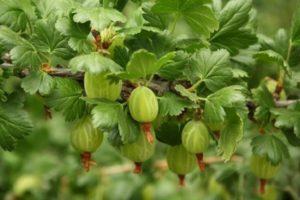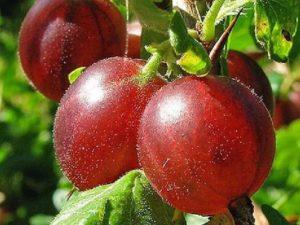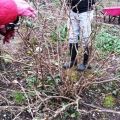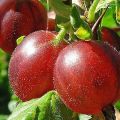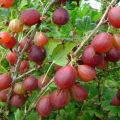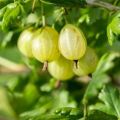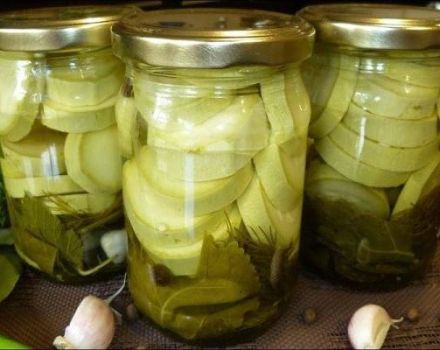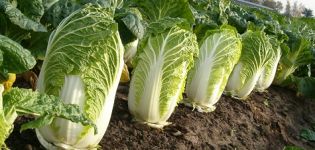Characteristics and description of Beryl gooseberries, planting and care
Gooseberries have long been valued for their taste and benefits. However, the shrub was always not resistant to frost and disease, and harvesting was complicated by scratches from the thorns covering the branches. Therefore, breeders tried to develop a more malleable variety. A new type of gooseberry, which appeared due to crossing, was named Beryl, and he became a favorite of gardeners for its unsurpassed qualities.
Description of the variety
Gooseberry Beryl differs from its congeners, having absorbed the best from the "parents" - varieties Malachite and Nugget.
Bushes
The appearance and characteristics of the bush:
- average height - about a meter, medium spreading, with a dense crown;
- shoots of medium thickness are curved and hanging;
- thorns are sparse and weak, mainly on the lower shoots, and directed downward;
- leaves are bright green, soft and large, have three or five lobes without drooping;
- Beryl flowers are green or reddish, glass-shaped, grow in pairs, forming a two-color inflorescence.
Berries
Description of gooseberries Beryl should start with the main advantage - their weight can reach 9 grams. The fruits themselves are round, with a thin, but elastic, pale green, sometimes with redness, skin and characteristic vertical veins. The taste is sweetish-sour, the pulp is juicy. There are few seeds inside. The peduncles are thin and long.
Characteristics of gooseberry beryl
In addition to external differences, Beryl has special characteristics that distinguish it from other varieties.
Disease and pest resistance
Gooseberry has a fairly strong immunity to most diseases, especially powdery mildew and downy mildew. As for pests, Beryl is rarely attacked by insects.
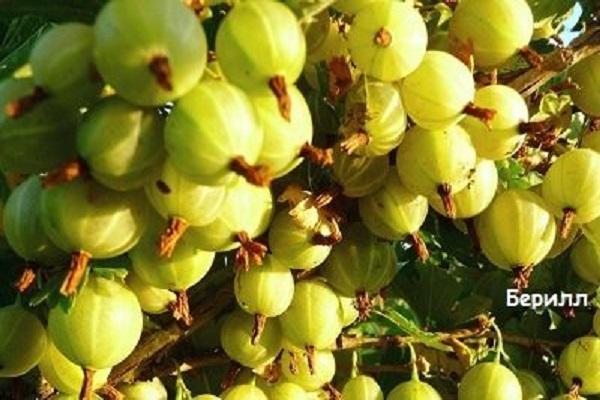
Drought resistance and frost resistance
Beryl is a frost-resistant gooseberry variety. It does not require winter shelter and is able to withstand temperatures down to -38 ºC, which makes it an ideal choice for gardeners in Siberia and the Urals.
With respect to drought, the plant is also unpretentious and does not require frequent watering, even on a hot day. However, leaving the bush completely without water is not worth it.
Important! Beryl is very sensitive to excess moisture.
Ripening period and yield
Beryl is classified as a medium late ripening variety. By mid-July, gardeners get a decent harvest.An adult bush brings 5-10 kilograms per season. The number of berries does not depend on weather conditions, but on the quality of care and the age of the plant. The gooseberry yields the highest yield five years after planting.

Transportability
Despite the thin skin, the berries tolerate transportation well. At the stage of technical maturity (a little immature) they can easily withstand three days of transportation. If the crop is harvested during the period of removable maturity (full ripening), then transporting over long distances is problematic.
Using berries
The fruits of the thornless Beryl are considered dessert, since the sweetness exceeds the sourness. In addition to its taste, gooseberry has a whole storehouse of beneficial vitamins and minerals, which:
- help with dysfunctions of the gastrointestinal tract;
- improve the work of the cardiovascular system;
- tone and strengthen the body;
- daily consumption contributes to weight loss.

Important! Berries should be eaten with caution by people with diabetes.
In addition to the consumption of pure gooseberries, desserts (jams, marmalade, compotes, etc.), sauces, marinades and alcoholic tinctures are made from them. Also, berries are often used for cosmetic purposes - masks, creams or scrubs.
Main positive and negative aspects
Beryl has a lot of advantages over other varieties:
- the plant is self-fertile, and does not require additional pollination, which brings up to 50% of the yield;
- compared to other types of gooseberries, beryl is more fruitful;
- the berries are large, with a special taste;
- fruits tolerate transportation well;
- frost resistance and drought resistance;
- immunity to most diseases and resistance to pests;
- a small number of thorns.
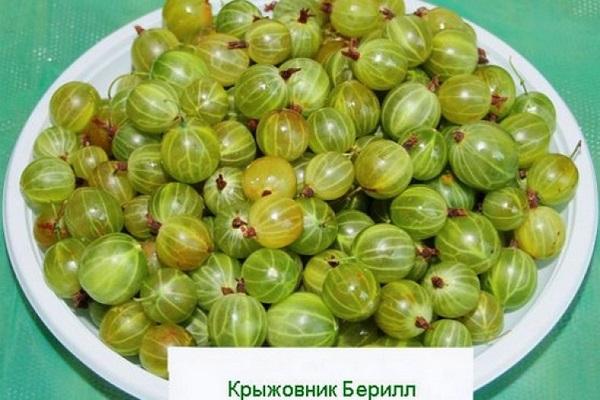
However, the gooseberry is not without its drawbacks, which are much less:
- low resistance to septoria and sawflies;
- ripe fruits do not tolerate transportation well;
- without proper care, yields are reduced.
The subtleties of growing a culture
As with any plant, the correct planting and cultivation of Beryl is important - the further growth and fertility of the shrub depends on it.
Soil requirements
Before planting gooseberries, several conditions must be met:
- the soil should not be acidic. Otherwise, the acidity must be reduced with limestone or dolomite flour at the rate of 300 grams per bush;
- the planting hole should be dug up, cleared of weeds and debris;
- if the soil is heavy, it must be diluted with a mixture of sand and humus;
- fertilize the soil with 20 liters of humus, 150 grams of ash and 25 grams of potassium phosphate and superphosphate.

It is better to plant gooseberries on elevations where there is free access to the sun's rays and there are no strong winds.
Important! Beryl should not be planted in swampy areas and in places where groundwater flows near the surface.
Boarding time
Beryl should be planted in the spring or autumn (late September-early October) period, several weeks before the cold weather, so that the roots take root.
Important! The temperature at night should not drop below 5 degrees.
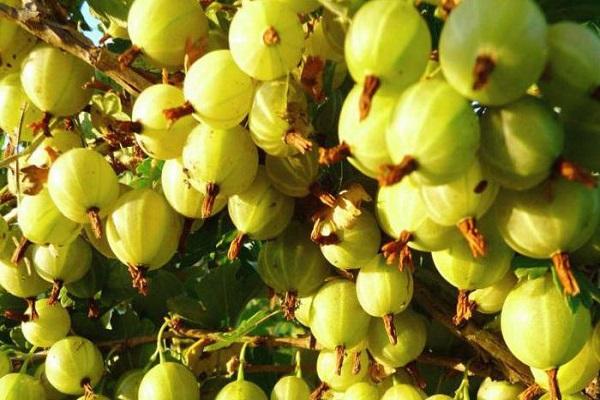
Selection of planting material
Choosing a Beryl gooseberry seedling is an important process. An unsuccessful bush may not take root or produce a bad harvest. Therefore, when purchasing gooseberries, preference should be given to seedlings:
- with an open root system.
Age - no more than 2 years old, with 2-3 strong shoots, no shorter than 20 centimeters. The kidneys are enlarged, but not open. Greens can cover the tops. Roots are moist and well developed. Externally, the seedling should not be damaged;
- with a closed root system (container growing).
There is no specific age. Developed and leafy shoots - 40-50 centimeters. Important! The roots should form a dense clod of earth. External damage is not allowed.

Disembarkation process
It is imperative to place the gooseberry seedling in the ground correctly:
- dig a deep hole, fill it with compost and compact so that there are no voids. Important! The planting pit is fertilized only during spring planting. In autumn, fertilizers are not needed - various types of parasites and diseases like to winter in them;
- place the seedling strictly vertically. The core of the shrub is 8 centimeters deep into the soil;
- the roots are distributed evenly;
- when filling the soil, the layers should be carefully tamped so that there are no voids, and the earth tightly covered the bush;
- after planting, the buds are trimmed so that there are no more than 5 on each branch;
- pour a bucket of water;
- after soaking, sprinkle sawdust or leaves on the ground.
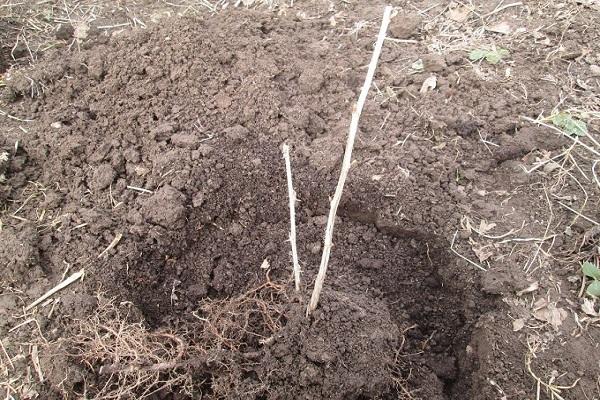
The nuances of plant care
Unpretentious Beryl does not require complicated care, but it is necessary for the growth and fruiting of the bush.
Watering
In dry summer, water the gooseberries at least 1 time a week, especially at the time of flowering and ripening. Pour a bucket of water into the trunk circle, avoiding contact with leaves and shoots.
Important! 2-3 weeks before harvest, frequent and heavy watering will degrade the quality of the berries. If the summer is rainy, no additional fluid is required.
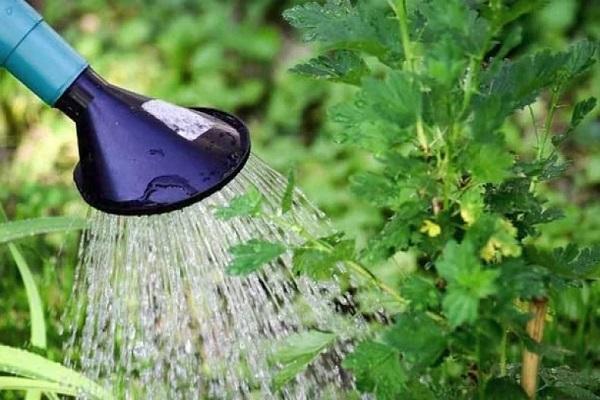
Soil care
For better and healthy growth of gooseberries, it is necessary to regularly loosen the soil (4-5 times per season) and remove debris and weeds. This will help the roots get the air they need.
Important! Loosening is carried out carefully so as not to harm the root system. In addition, mulching will have to be done to retain moisture in the ground.
Top dressing
Annual soil fertilization with useful substances is extremely necessary to obtain a regular and high-quality gooseberry harvest:
- in early spring, mulching with humus is carried out;
- at the end, fertilize the soil with minerals (ammonium nitrate) or organic (dung, manure);
- after flowering - potassium phosphate or superphosphate;
- in the first half of autumn, before cold weather - a mixture of potassium phosphate, superphosphate and magnesium.

Pruning
Regular pruning of gooseberries is necessary to keep the bush from overgrowing and to form new shoots. To do this, every spring, after the snow melts, old, diseased or damaged branches should be cut off. Annual shoots should be shortened. Leave 4-5 of the strongest of the basal ones. Cut the main branches by half. As a result, no more than 20 branches of different ages should remain on the bush.
Protection from winter cold
Start preparing gooseberries for cold weather when the average temperature drops below 0 ° C. During this period it is necessary:
- water the bush with 4-5 buckets of water;
- lower the branches to the ground and fix. Important! Distance from the ground - 8-10 centimeters;
- mulch the soil with a layer of at least 8 centimeters, at temperatures below 15 ° C - a layer of 20 centimeters;
- in snowy weather, cover the bush with snow.
In early spring, all shelters must be removed to avoid premature bud formation and freezing.

Diseases and pests
Despite the high resistance of Beryl to various types of fungi and insects, this variety still has an "Achilles heel". Gooseberry is susceptible to septoria, a fungal disease that occurs on the leaves. In the absence of timely treatment, the fungus spreads, the amount of harvest drops noticeably, and the plant dies.
With regard to insects, species of sawfly, aphids and moths are susceptible to shrubs. Without the necessary treatment, the parasites will eat all the leaves, making the bush sick.
Reproduction methods
Beryl propagates in three ways: by cuttings, dividing the bush or by grafting. The gardener himself determines the suitable option.
Collection and storage
Ripening of berries is simultaneous. In the northern regions it begins in mid-July, in the southern regions from June. The shelf life of Beryl gooseberry fruit is within 7 days.
